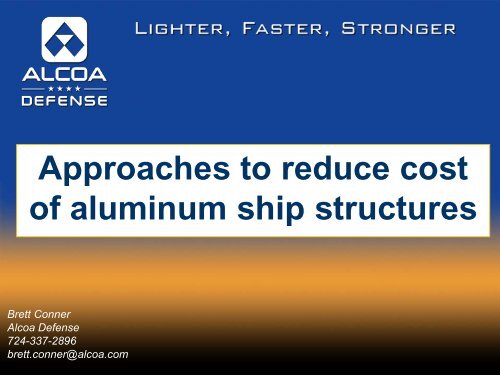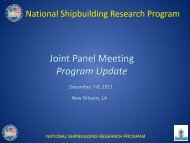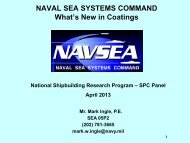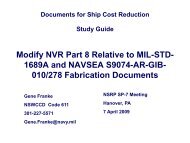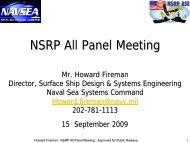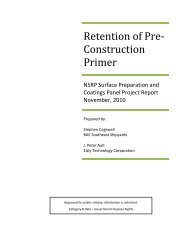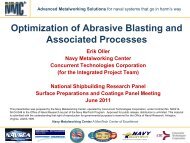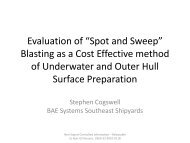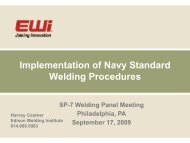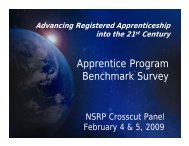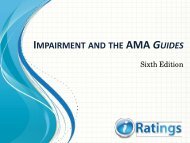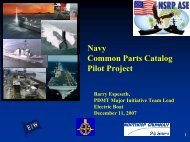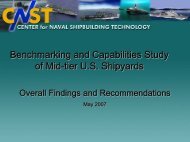Approaches to reduce cost of aluminum ship structures - NSRP
Approaches to reduce cost of aluminum ship structures - NSRP
Approaches to reduce cost of aluminum ship structures - NSRP
- No tags were found...
You also want an ePaper? Increase the reach of your titles
YUMPU automatically turns print PDFs into web optimized ePapers that Google loves.
<strong>Approaches</strong> <strong>to</strong> <strong>reduce</strong> cos<strong>to</strong>f <strong>aluminum</strong> <strong>ship</strong> <strong>structures</strong>Brett ConnerAlcoa Defense724-337-2896brett.conner@alcoa.com
Overview• What Alcoa and <strong>aluminum</strong> bring <strong>to</strong> the <strong>ship</strong> builder• Alcoa’s Collaborative Development Approach (ACDA)• Design for <strong>cost</strong> and <strong>cost</strong> modeling• Results2
MiningAlumina• Founded in 1888.• 34 Countries; 450 locations.• 97,000 Employees.• $31 Billion Revenue in 2007.• World-Class Aluminum Expertise.• Technology Leader.AerospaceAu<strong>to</strong>motiveSmeltingCommercialVehiclesIngotDefensePlateSheetExtrusionAl, SA, TiCastingsForgingsFastenersBuildings3
Technology Leader<strong>ship</strong>UnparalleledLightweight MetallicsTechnologyMetallics database unrivaled by any firm anywhere in theworld, the product <strong>of</strong> more than 100 years <strong>of</strong> research andengineering expertise– More than 60 years <strong>of</strong> experience in developing alloysand products for defense applicationsStructural DesignCompetenciesCritical design <strong>to</strong>ols and competencies recognized inmultiple industries, including au<strong>to</strong>motive, aerospace anddefense– Design capabilities not limited <strong>to</strong> a single material orproduct, but covering a range <strong>of</strong> solutions, includingthose that call for integration <strong>of</strong> <strong>aluminum</strong> with othermaterialsFabrication andAssembly CapabilitiesStrong manufacturing pedigree, chiefly born <strong>of</strong> its workmanufacturing integrated <strong>structures</strong> for the au<strong>to</strong>motiveindustry– Extensive experience in producing pro<strong>to</strong>types rangingfrom full assemblies <strong>to</strong> individuals parts– Manufacturing and assembly issues viewed as criticalelements in the design process4
Alcoa Science & Technology7 Research & Development Locations:• Alcoa Technical Center, PA, USA• Alicante, Spain (fabrication)• Carson, CA, USA (fastening systems)• Crawfordsville, IN, USA (closures)• Kwinana, Australia (refining)• Richmond, VA, USA (packaging)• Whitehall, MI, USA (castings)3 External Technology Offices:• Beijing, China• Moscow, Russia• New Delhi, IndiaAlcoa Technical Center (ATC):• World’s largest light metals research facility• 600 scientists, engineers, technicians &support personnel• Full range <strong>of</strong> lab capabilities• Bench-scale <strong>to</strong> full production-scaleequipment & facilities• Research, Development and AppliedEngineering across all products, markets andprocesses5
ATC Core CapabilitiesProduct Design / DevelopmentBasic Science & Metallurgy• Alloy & temper development• Mechanical characterization• Deformation process design• Numerical simulations(material & process)• Metallurgical & engineeringstds.• Microstructurecharacterization• Constitutive equation dev.• Thermal process design• Subscale experimentalsimulation• Analytical Chemistry• Environmental Science• Surface ScienceManufacturing Systems /Technology• Control systems• Measurement systems• Manufacturing systemsanalysis• Statistical methodsMetal Processing• Melting/recycling• Metal treatment• Ingot casting• Continuous casting• Process analysis• Solidification• Particulate processing• Product design for:– Performance– Manufacturing– Cost• Computer-aided-engineering /design (CAE/CAD)• Design systems / methods /guidelines development• Material mechanics /characterization• Validation testingProduct Manufacturing• Metal shaping / forming• Machining / Metal removal• Joining & assembly• Rapid pro<strong>to</strong>typing & <strong>to</strong>oling• Engineered Surfaces &Finishes6
Advantages <strong>of</strong> <strong>aluminum</strong> in marine<strong>structures</strong>• Specific strength: high strength-<strong>to</strong>-weight ratio and density one-third that <strong>of</strong>steel• Excellent corrosion resistance in the marine environment:• Example: 5xxx series <strong>aluminum</strong> alloys do not need <strong>to</strong> be painted• Weldable• Formable• Recyclable• Ease <strong>of</strong> machining and ease <strong>of</strong> handling• Availability and diversity <strong>of</strong> semi-finished products <strong>to</strong> incorporate in<strong>to</strong> <strong>ship</strong><strong>structures</strong>• Non-magnetic7
Alcoa’s Navy Initiative• Alcoa recognizes the resurgence in <strong>aluminum</strong> <strong>ship</strong>s, and the Navy’s past andcurrent challenges with them.• Alcoa has a strategic initiative <strong>to</strong> help advance <strong>aluminum</strong> <strong>ship</strong> structurematerials, design and manufacturing.• Alcoa’s Navy initiative is aimed at improving <strong>cost</strong>, weight and performance <strong>of</strong>primary <strong>ship</strong> structure (hull, deckhouse and structural fittings).• Alcoa is <strong>of</strong>fering its world-class experience and capabilities: Unmatched lightweight metallics knowledge Proven lightweight high-performance structural design capabilities Design <strong>to</strong>ols, rules and standards Component, sub-assembly and systems manufacturing know-how• Alcoa’s multi-disciplinary approach and collaboration model have deliveredtremendous platform advancements in other industries (Commercial and DoD).• Program pull and support from the Navy and industry are needed <strong>to</strong> achievecomparable results.8
Naval Structures Initiative (NSI)• First formal engagement and contract activity (in recenthis<strong>to</strong>ry) between Alcoa and the Navy.• Support research and development <strong>of</strong> improved lightweight<strong>aluminum</strong> <strong>structures</strong> for LCS and other HSVs.• Alcoa and the Navy created IPTs with members from PEOShips, NAVSEA 05, NSWCCD, ABS, Primes, Shipyards, andNaval Architects: IPTs were setup in March 2008 sub-IPTs for each LCS JHSV being added in 20099
elas<strong>to</strong> - plasticboundar yMeeting the Ship ConstructionChallenge with Alcoa ExpertiseAlcoa can provide the innovations in <strong>ship</strong> design and construction required by the Navy andindustry <strong>to</strong> create more affordable vessels that will meet mission requirementsMaterial KnowledgeStructural DesignDesign Rules & ToolsManufacturingKnowledgeAlcoa is a leader in<strong>aluminum</strong> alloy researchand developmentAlcoa is a proven industrypartner for <strong>aluminum</strong>design solutions and candeliver trade studies foralternative designs <strong>to</strong> theNavy addressingWith decades <strong>of</strong> designand production experiencein <strong>aluminum</strong>, Alcoa has abreadth <strong>of</strong> knowledge thatcan be applied <strong>to</strong> theoptimization <strong>of</strong> navaldesign rules and <strong>to</strong>olsAlcoa’s advances in nextgenerationmanufacturingtechnology10
Structural Design Capabilities• Alcoa’s design technologies have been successfully leveragedacross multiple commercial and defense market segments– Rail cars– Transportation systems such as bulk trailers and intermodalcontainers– Cars and trucks– Commercial aerospace– Defense aerospace, land and marine systems• Design is driven by cus<strong>to</strong>mer performance requirements andstandards– Alcoa has found that its design competencies and <strong>to</strong>olkits are fullytransferable <strong>to</strong> other market segments once we learn a cus<strong>to</strong>mer’sperformance requirements and standards11
Alcoa Joining Process ResearchAlcoa is a leader in cutting-edge joining research, cover a broad gamut <strong>of</strong>technologies and applicationsAlcoa Joining Process Research AreasFriction Stir Welding (FSW)Gas Metal Arc Welding (GMAW)Magnetrically Impelled Arc ButtWelding (MIAB)• High frequency inductionresistance welding• Low and high temperaturebrazing• High temperature soldering• Magnetically impelled arc buttwelding (MIAB)• Gas metal arc welding(GMAW)• Flash welding• Resistance Spot welding withand without adhesives• Riveting (eg., Riv-bonding,blind rivets, self-piercingrivets, etc.)• Adhesive Bonding• Friction stir welding– Conventional– Fixed Bobbin <strong>to</strong>ols• Friction welding• Laser beam welding with andwithout wire• Laser-Stir welding• Hybrid GMA/Laser welding• Hybrid Plasma/Laser welding• Cast joining• Double-wire gas metal arcwelding• Cold wire assisted plasmawelding• High frequency resistancewelding12
Alcoa Collaborative Development Approach (ACDA)- Collaborative IPT Teams (OEM, Alcoa, Military) -Phase IPhase IIPhase IIIPhase IVPhase V-Identify and Select Candidate Assemblies/Components-Develop and Evaluate Conceptual Designs-Finalize Conceptual Designs and Analyses-Develop and Evaluate Pro<strong>to</strong>types-Implement Designs in ProductionPartID1stgateConceptDesign2ndgateFinalDesign3rdgatePro<strong>to</strong>typing4thgateI II III IV VEx. Activities:Production• Opportunityidentification• Gather geometry,packaging, load req’s• Develop conceptredesign options• Prelim. evaluation <strong>of</strong>conceptual redesigns• Down-selectconcepts for furtherdevelopment• Finalize partredesigns – detailedCAD and analysis• Evaluate advanceddesign concepts• Finalize <strong>to</strong>tal <strong>cost</strong>sand plans forpro<strong>to</strong>typing• Develop pro<strong>to</strong>typepart fabrication andtest plans• Produce pro<strong>to</strong>typeparts• Test pro<strong>to</strong>types andapprove forproduction1313
Collaboration: Who should beinvolvedShipyardPrimeNavalArchitectsProgramOfficeShipDesignManagersTechnicalWarrantHoldersABSNSWC
Design for Cost• Once <strong>structures</strong> are identified as opportunities for <strong>cost</strong> savings, Alcoa canbegin <strong>to</strong> develop concepts• Collaboration with the cus<strong>to</strong>mer(s) identifies requirements and targets• The baseline structure or component must be defined and agreed upon• The baseline is then <strong>cost</strong> modeled• As concepts are developed they are <strong>cost</strong> modeled• The concepts are then evaluated for the above criteria• This process continues as concepts are downselected and refined15
16Cost Modeling Methodology• Manufacturing <strong>cost</strong>s assessments developed with SEER-DFM(www.galorath.com), a commercially available s<strong>of</strong>tware <strong>to</strong>ol commonlyemployed in the Aerospace and Defense Industries– Parametric <strong>cost</strong> estimation based upon the application, platform, sizing,material, au<strong>to</strong>mation, etc. defined by the user.– Develops <strong>cost</strong>s by comparing the user’s entries with similar items in ahis<strong>to</strong>rical database.– Provides Recurring Manufacturing Costs for Individual Manufacturing Steps(labor, materials, and <strong>to</strong>oling)• Welding, Machining, NDT, Bolting, etc.– Does not provide NRC development <strong>cost</strong>s and labor
17Manufacturing Cost Assessment• Commercial <strong>cost</strong>ings<strong>of</strong>tware, SEER-MFG(www.galorath.com)employed by majorAerospace andDefense industries• Piece and processbased<strong>cost</strong> structuredeveloped• Processes includemachining, surfacepreparation, fitup andwelding operations.17
18SEER-DFM Overview• Create or Refine Work BreakdownStructure Based Upon Design &Flowpath• Define Inputs <strong>to</strong> EachManufacturing Step
19An example19
Cost Estimates and ConceptEvaluation• Do any <strong>of</strong> the concepts meet your <strong>cost</strong> targets?• Are there other fac<strong>to</strong>rs that need <strong>to</strong> be considered such as weight orrepairability?20
Total Owner<strong>ship</strong> Cost• True <strong>ship</strong> <strong>cost</strong>s extend beyond the <strong>cost</strong> <strong>to</strong> build the <strong>ship</strong>. These include:• Cost <strong>to</strong> maintain the <strong>ship</strong> structure including manpower <strong>cost</strong>s• Cost in fuel <strong>to</strong> operate the <strong>ship</strong>• For commercial vessels, <strong>cost</strong>s incurred by heavier than necessary <strong>structures</strong>• Hedlund-Åström 2009 in a life cycle <strong>cost</strong> analysis shows a 50% weightsavings design for a Ro-Ro superstructure by switching <strong>to</strong> <strong>aluminum</strong>• Weight reduction used as increased payload resulting in a break-evenpoint <strong>of</strong> around 5 years <strong>of</strong> operation• Costs <strong>to</strong> dispose <strong>of</strong> the vessel• Environmental fac<strong>to</strong>rs• Ship designers and builders should use <strong>aluminum</strong>’s advantages <strong>to</strong> <strong>reduce</strong>life cycle <strong>cost</strong>• These life cycle fac<strong>to</strong>rs can impact the <strong>ship</strong>building <strong>cost</strong>s as it candetermine which <strong>cost</strong> saving concepts are selected for application21
Results• Each opportunity identified that required a solution in <strong>cost</strong> has resulted in50-70% savings in recurring manufacturing <strong>cost</strong>• Each opportunity identified that required a solution in weight has receivedbetween 15-60% savings in weight• Immediate pay<strong>of</strong>fs: solutions are being inserted on<strong>to</strong> LCS-3 and LCS-422
Summary• Alcoa recognizes the resurgence in <strong>aluminum</strong> <strong>ship</strong>s, and the Navy’s pastand current challenges with them• Alcoa has a strategic initiative <strong>to</strong> help advance <strong>aluminum</strong> <strong>ship</strong> structurematerials, design and manufacturing• Alcoa is <strong>of</strong>fering its world-class experience and capabilities: Unmatched lightweight metallics knowledge Proven lightweight high-performance structural design capabilities Design <strong>to</strong>ols, rules and standards Component, sub-assembly and systems manufacturing know-how• Alcoa’s multi-disciplinary approach and collaboration model are deliveringresults saving <strong>cost</strong>s and weight for <strong>ship</strong>builders23


